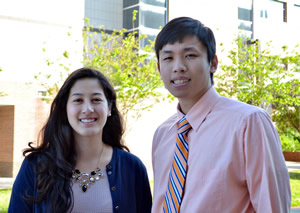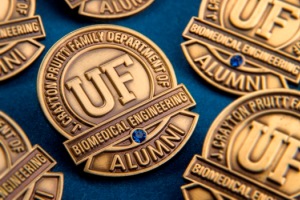The College of Engineering is making history this May as it graduates its first class of undergraduate students from the J. Crayton Pruitt Family Department of Biomedical Engineering.
Generous gifts from the Pruitt family helped to grow a thriving biomedical engineering (BME) department on the UF campus over the course of a decade. Then in 2012, after several years of specializing in graduate-level and doctoral research, the undergraduate program opened its doors. Students are now offered four specialization tracks: Neural Engineering, Imaging and Medical Physics, Biomaterials and Tissue Engineering, and Biomechanics and Modeling.
“I am particularly proud of this inaugural class,” says Christine Schmidt, professor and chair of the BME department. “As the first students in a new program, they entrusted us with their careers and were willing to take the risks that exist with any new endeavor. Thus, they are a self-selected group defined by their willingness to take chances and think outside the box. These qualities, combined with the rigorous and interdisciplinary technical training in the BME curriculum, will allow them to be true leaders in their field, and to help develop the next generation of technologies that will impact human health. In addition, this first class of graduates sets the bar high for students who follow, and serves as the foundation for our undergraduate program for the future.”
Biomedical engineering senior Amanda Eifert, 22, is on the biomechanics track and is one of the first students to earn a Bachelor of Science degree from the undergraduate program. With an interest in joints and injuries, Eifert’s most memorable assignments have been those where she had the opportunity to experiment with biological and mechanical solutions to medical problems.
As graduation approaches, Eifert is thankful for the opportunity to pursue the goals she initially had her heart set on. “I think it’s really cool to be part of the first class of BME students,” Eifert said. “I’m actually more relieved than anything that I came in at the right time to be able to be a part of the program, and to not have to find some alternative route to the degree I really wanted.”
Philip Vu, 22, is also graduating from the program in May after studying the neural engineering track. He’s been researching brain computer interfaces, and manipulating brain signals for the movement of prosthetics.
Long before graduating and entering the job market, Vu has already had opportunities to help real patients. “We have a patient who has neural problems that are not diagnosed. His neurologist does not know what’s actually wrong,” said Vu. The patient experiences sudden imbalance and loses coordination mid-stride, so Vu and his senior design class are building a device to send electrical stimulation to the back of the patient’s ears, the area responsible for balance. “It’s a real challenge, actually,” said Vu, who expressed excitement in being able to improve the life of a real patient through his work. He wants to pursue doctoral research in brain computer interfaces and neural engineering. He’s applied to UF.
This is the kind of innovative work that surgeon J. Crayton Pruitt envisioned for the department when he invested in it. When a heart attack put Pruitt in the patient role, and a biventricular assist device bought him enough time to find a heart donor, his eyes were opened to the importance of bringing technology and medicine together.
Hans van Oostrom, associate chair of BME, says “the real power of a BME degree is that students are prepared to work at the interface of engineering and medicine.” He said undergraduate students are benefiting from increased collaboration with clinicians on design projects. “We are perfectly situated right in the middle of UF’s Health Science Center, with great access to the medical clinics and departments. And the road ahead includes continuous improvement with new courses and more laboratories.”
The students agree. “Being a part of BME is exciting . . . the field is constantly making new discoveries,” said Eifert, who has already begun graduate studies and has one year remaining at UF before she earns her master’s degree. She’s hoping to find a career in the biomedical industry that will allow her to travel the world.

BME undergraduates and NSF award recipients, Aline Yonezawa and Philip Vu
Within the small inaugural class, both Vu and his classmate Aline Yonezawa have received highly prestigious National Science Foundation Graduate Research Fellowships. This fellowship is a program that acknowledges distinguished graduate students pursuing master’s and doctoral degrees in science, technology, engineering, and mathematic disciplines. It has ranked UF eighth nationwide in the number of biomedical engineering fellowship recipients.
“To be awarded the NSF graduate fellowship is one of the biggest accomplishments I could have achieved in my undergraduate career,” said Yonezawa, who believes the BME department and faculty members have prepared her for future endeavors in graduate school.
On May 3rd, before sending its first undergraduate class to don their regalia and garner their diplomas, the BME department will begin an annual tradition with its first ever pinning ceremony. Each of the 17 graduates will receive a custom-designed BME alumni pin, acknowledging his or her achievements and serving as a reminder of the ethical responsibilities that accompany a biomedical engineering education. Each pin will be sponsored by an alumnus, faculty member, industry partner or staff member. In future ceremonies, BME alumni will be able to sponsor pins for graduates who are following in their footsteps.
Author: Kristi Camara, College of Engineering
